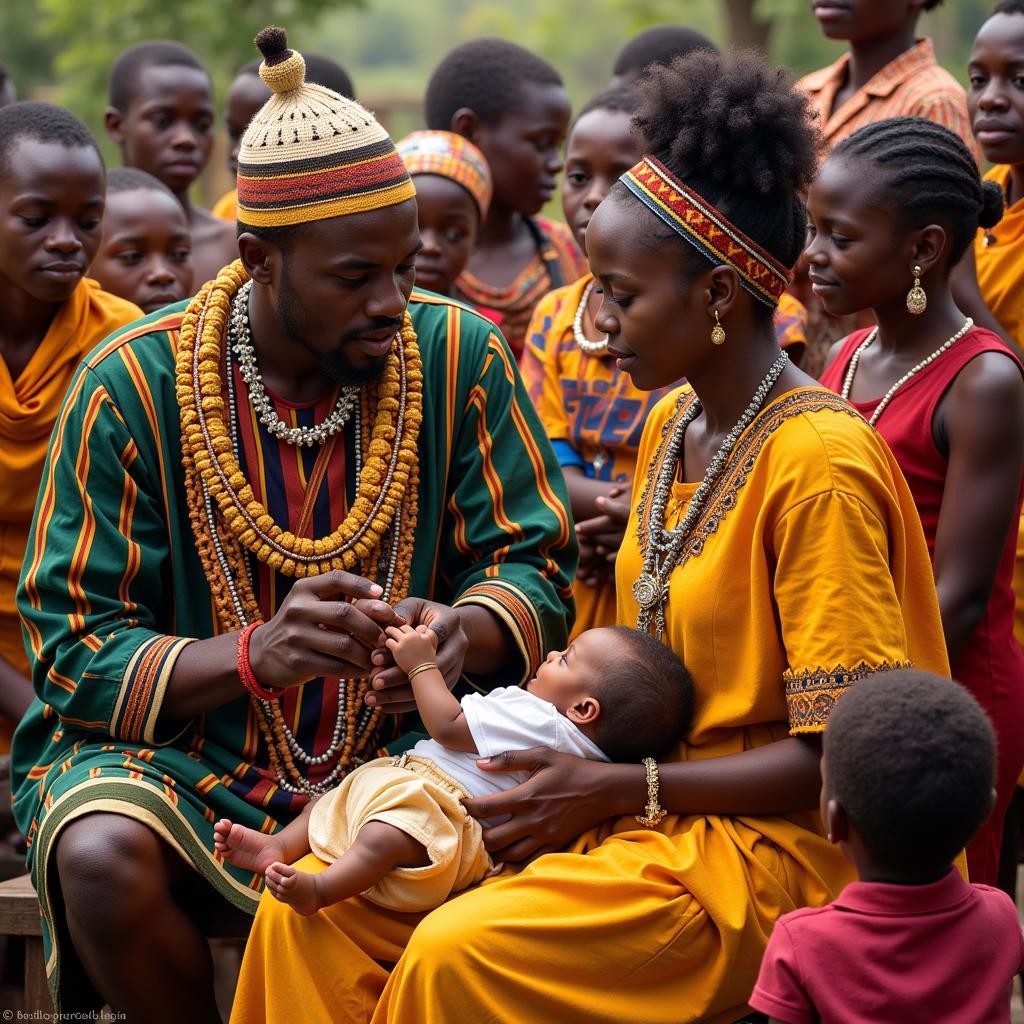Exploring the Vibrant World of African Fabric Styles
African Fabric Styles are a vibrant tapestry of cultural expression, historical significance, and artistic innovation. From the intricate patterns of kente cloth to the bold designs of Ankara, these textiles tell stories of heritage, tradition, and contemporary fashion. This article delves into the rich world of African fabric styles, exploring their unique characteristics, origins, and the ways they continue to inspire designers and fashion enthusiasts globally.
A Journey Through the History of African Fabric Styles
African textiles have a long and fascinating history, with evidence of weaving and dyeing techniques dating back centuries. These fabrics played a crucial role in various aspects of life, from clothing and adornment to ceremonial rituals and social status. For example, specific patterns and colors often signified a person’s clan, tribe, or social standing. The evolution of African dresses styles 2019 showcases a beautiful blend of traditional elements with modern aesthetics.
The Significance of Symbols and Motifs
Many African fabric styles incorporate symbolic patterns and motifs that hold deep cultural meaning. These symbols can represent anything from ancestral spirits and proverbs to historical events and natural elements. Understanding the symbolism behind these designs provides valuable insights into the rich cultural heritage they represent. This symbolic language makes African fabrics more than just clothing; they are a powerful form of visual communication.
Popular African Fabric Styles: A Kaleidoscope of Colors and Textures
The continent boasts a dazzling array of fabric styles, each with its own distinctive characteristics and cultural significance. From the elaborate kente cloth of Ghana to the striking Aso Oke of Nigeria and the vibrant Shweshwe of Southern Africa, these textiles showcase the diverse artistic traditions across the continent. Exploring these diverse African attire for sale options reveals the sheer breadth of creativity and craftsmanship.
Kente: A Royal Cloth of Ghana
Kente, a handwoven fabric from Ghana, is known for its intricate geometric patterns and vibrant colors. Traditionally worn by royalty and nobility, kente is a symbol of prestige and cultural pride. The colors used in kente also hold symbolic meaning, with each color representing a specific concept or idea.
Aso Oke: A Timeless Nigerian Textile
Aso Oke, a hand-loomed cloth from Nigeria, is characterized by its intricate patterns and rich textures. It is commonly used for ceremonial attire and special occasions, reflecting its importance in Nigerian culture. The different weaving techniques and patterns used in Aso Oke often signify specific regions or ethnic groups.
What are some common uses of African fabric styles?
African fabric styles are used in a wide range of applications, from traditional clothing and accessories to contemporary fashion and home decor. They are increasingly being incorporated into modern designs, adding a touch of African flair to global fashion trends. You can find beautiful examples of African bride part 6 featuring stunning traditional attire.
“African fabrics are not merely pieces of cloth,” says Abena Serwaah, a renowned Ghanaian textile artist, “they are woven narratives that capture the essence of our history and culture.”
How can I incorporate African fabric styles into my wardrobe?
Integrating African fabric styles into your wardrobe is a wonderful way to embrace vibrant colors and unique patterns. From dresses and skirts to shirts and accessories, there are countless ways to incorporate these textiles into your personal style. Looking for inspiration? Check out these African fashion styles 2016.
“Don’t be afraid to experiment with different styles and combinations,” adds Adeola Olayinka, a Nigerian fashion designer. “African fabrics offer endless possibilities for creating bold and unique looks.”
The Future of African Fabric Styles
African fabric styles continue to evolve and inspire, with contemporary designers pushing the boundaries of creativity and innovation. These textiles are gaining increasing recognition on the global stage, showcasing the rich artistic heritage of Africa to the world. Looking for African attire online london linkedin? The digital age has opened up new avenues for accessing and appreciating these beautiful fabrics.
African fabric styles are more than just cloth; they are a testament to the rich cultural heritage and artistic ingenuity of the continent. From their intricate designs and symbolic meanings to their vibrant colors and textures, these textiles continue to captivate and inspire. By embracing and celebrating these fabrics, we not only support local artisans but also contribute to the preservation of a vital cultural legacy.
FAQ
- What is the most popular African fabric style? While many are popular, Ankara and Kente are widely recognized.
- How are African fabrics made? Many are handwoven or hand-dyed using traditional techniques passed down through generations.
- Are African fabrics expensive? The price varies depending on the type of fabric, the complexity of the design, and whether it is handmade or machine-made.
- Where can I buy authentic African fabrics? You can find them in local markets in African countries, as well as online retailers and specialty stores.
- How do I care for African fabrics? Care instructions vary depending on the specific fabric, but many can be hand-washed or dry-cleaned.
- Can I use African fabrics for home decor? Absolutely! They make beautiful curtains, upholstery, and other decorative items.
- Are there sustainable practices in African fabric production? Yes, many artisans and producers are focusing on sustainable dyeing and weaving methods.
Situations Where You Might Have Questions About African Fabric Styles
- Planning a wedding or special event and looking for unique attire.
- Designing a fashion collection and seeking inspiration from African textiles.
- Decorating your home and wanting to incorporate vibrant African patterns.
- Learning about different cultures and their artistic traditions.
- Shopping for gifts and souvenirs that reflect African heritage.
Explore Further
- Learn more about the history of African textiles.
- Discover different dyeing and weaving techniques used in Africa.
- Explore the cultural significance of various African fabric styles.
When you need help, please contact us by phone: +255768904061, email: [email protected], or visit us at: Mbarali DC Mawindi, Kangaga, Tanzania. Our customer service team is available 24/7.


